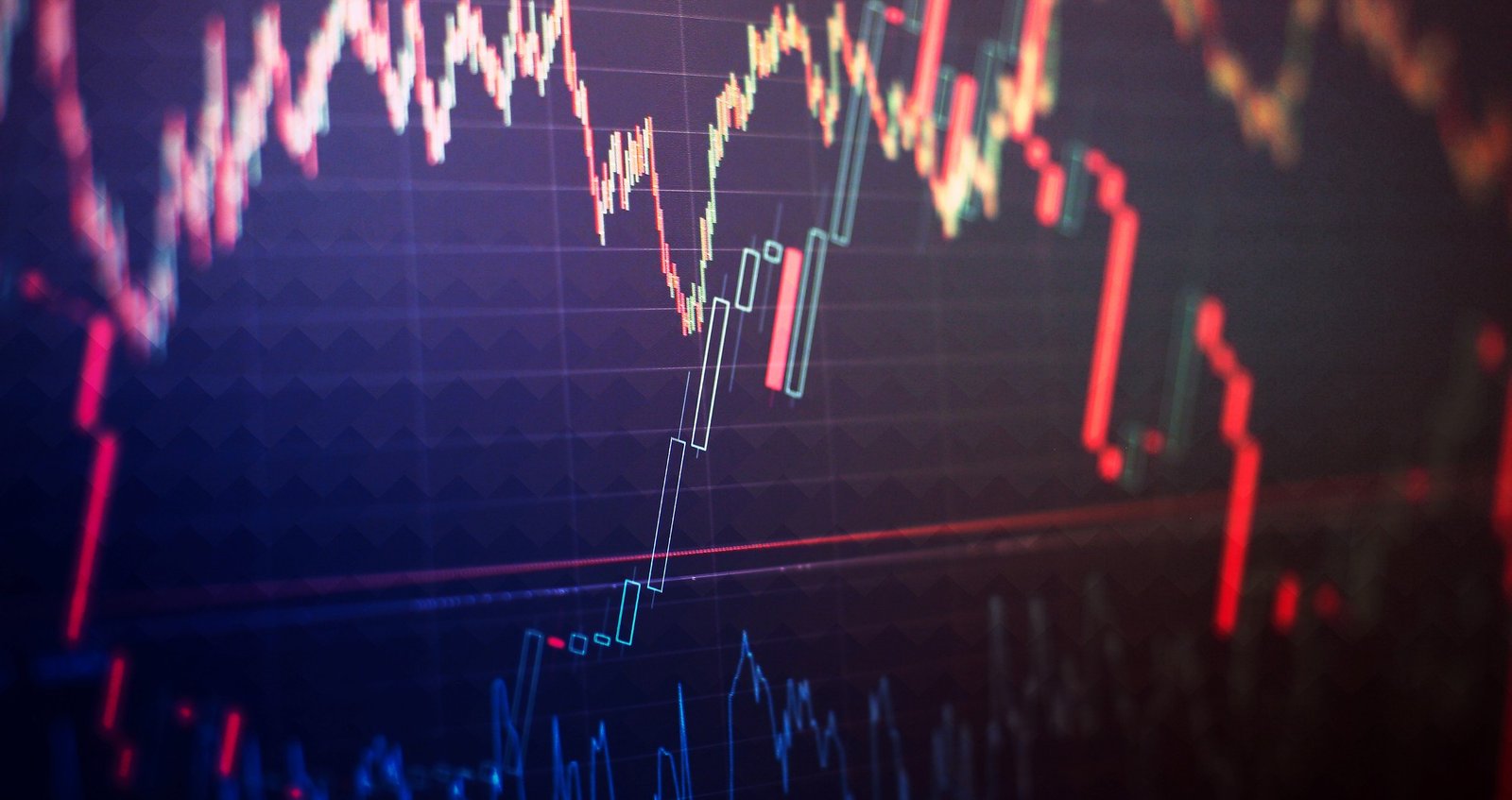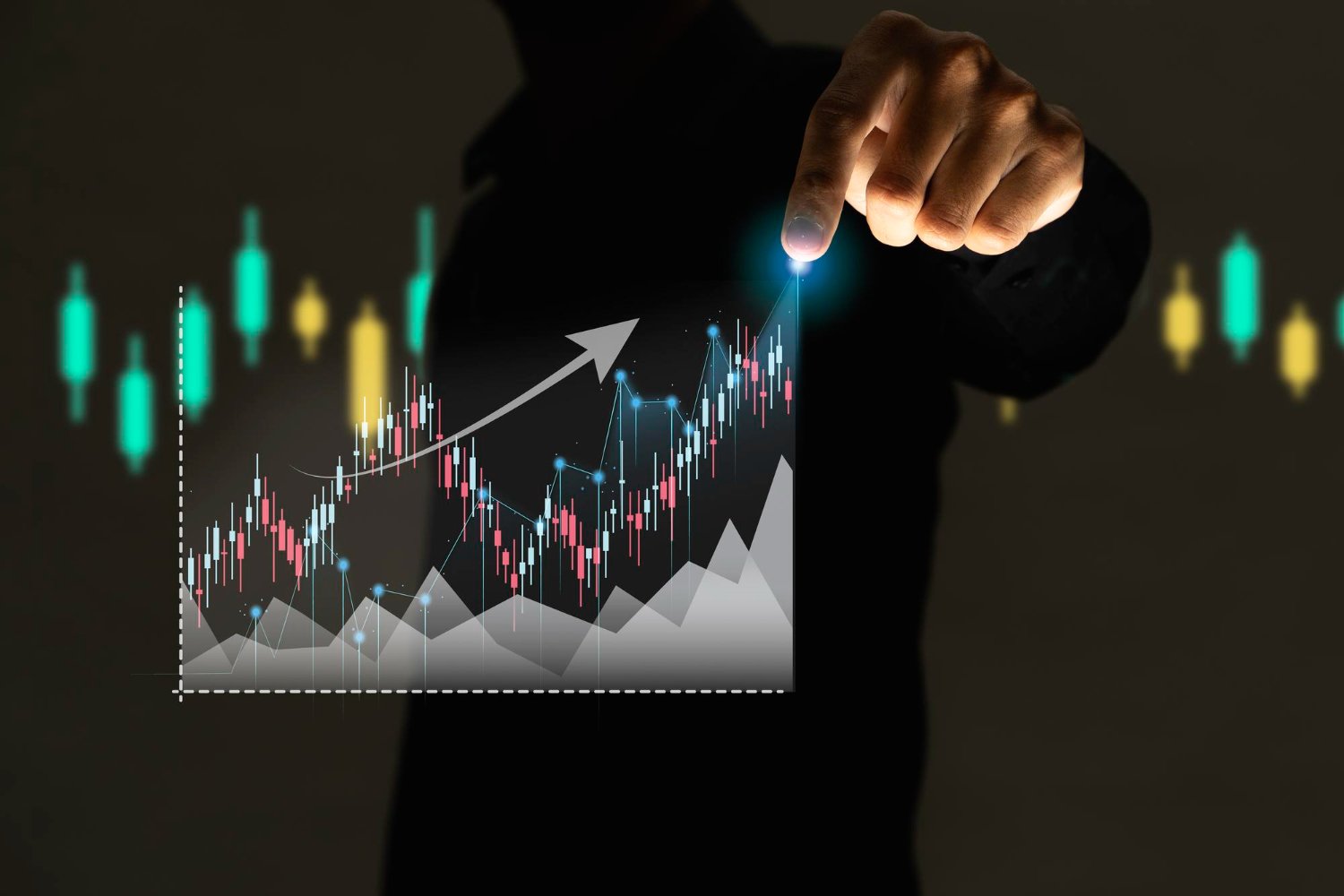Forex trading is a complex and volatile endeavor, requiring traders to navigate a constantly changing environment of currency values and economic indicators. As you navigate the perilous landscape of the forex market, you need all the help you can get to stay on course and avoid disaster. That’s where technical indicators come in – they’re like your trusty guide, pointing you in the right direction and warning you of potential pitfalls.
What Are Technical Indicators?
Technical indicators help traders make informed decisions on buying, selling, or holding assets using math calculations based on price and volume data to determine market trends and potential price movements. They’re particularly important in forex trading, allowing traders to anticipate price movements and identify trends and patterns.
Types of indicators include leading and lagging, with leading indicators predicting upcoming movements and lagging indicators assessing past trends and momentum. Traders can plot indicators on a price chart and use them with other forms of analysis, like fundamental analysis, to make informed investment decisions.
Why Technical Indicators Are Important For Forex Trading?
Technical indicators are essential for identifying the overall price trend, entry and exit points for every trade, and support and resistance level. Technical analysis helps you determine not only when to enter a market, but more importantly, when to get out. This is what makes it a helpful tool that should be considered in any trading strategy.
Learn Forex Technical Analysis Basics
The basis of technical analysis in the forex market involves studying past price movements to detect patterns and forecast future price fluctuations, aided by technical indicators and historical trends. In addition to chart analysis, technical analysis incorporates aspects of behavioral economics and risk management to achieve its objective of identifying profitable trades and predicting price trends.
Novice traders often consider technical analysis to be a simpler method of market analysis. Familiarizing oneself with the basics of technical analysis and tools can be enough to begin trading. As one becomes more proficient in technical analysis, it can be applied to any market, making it a versatile analytical tool.
Top Technical Indicators Used in Forex Analysis
What Are Forex Technical Indicators? Forex technical indicators are mathematical computations that rely on past price and volume data. Traders employ these indicators to scrutinize the market and arrive at informed trading choices. Forex indicators can furnish traders with a comprehension of the existing trends, momentum, and volatility of a particular currency pair. Furthermore, they can assist in detecting possible entry and exit points for trades.
The list of forex technical indicators include:
- Moving Averages (MA)
- Relative Strength Index (RSI)
- Stochastic Oscillator (SO)
- Ichimoku Kinko Hyo (Ichimoku)
- Bollinger Bands (BB)
- MACD (Moving Average Convergence Divergence)
- Fibonacci Retracement Levels
- Pivot Points
- Heiken Ashi
- DeMarker Indicator (DeM)
- Standard Deviation
- Bull Power and Bear Power
- Relative Vigor Index (RVI)Relative Vigor Index (RVI)
- Envelopes Indicator
- Commodity Channel Index (CCI)
- ADX Indicator
- Parabolic SAR
Let’s go over each in detail.
Moving Average (MA)
The moving average (MA) is a calculation to analyze data using the average change in a data series over time. It is a common technical analysis indicator that is used in identifying and spotting market trends. It is so popular because it is simple, versatile, and easy to apply.
Moving averages represent continuously calculated values that change constantly based on the average price changes in a set period of time. They mitigate price fluctuations by smoothing them out. So, they help in looking beyond transitory price effects and seeing the big picture and general trend instead.

MA are trend-following indicators that are commonly used to identify support and resistance levels as well as the overall trend. The shorter the time frame for the moving average, the more accurate it is, as in longer time frames the lags become greater. However, in shorter frames, the MA is more sensitive to price changes.
There are different types of moving averages out there, each is characterized by the way the data are weighted. The three basic and most common types of moving average (MA) are:
- Simple (SMA): It is the simplest formula of the moving averages, calculated by adding the set of values and dividing them by their count.
- Exponential (EMA): The calculation of this indicator gives more weight to recent prices.
- Weighted (WMA): It is a more complicated formula that assigns greater weight to recent prices, calculated by multiplying the given price by its weighting and totaling the values.
Fibonacci Retracement
Fibonacci retracement levels are used to measure how far prices will move against the current trend. They are drawn between the higher peak and lowest dip in a certain market movement to assess the continuity of a price pullback.
Fibonacci retracement levels are 23.6%, 38.2%, 61.8%, and 78.6%. 50% is also used as a retracement level although it is not an official level. These levels are used as support and resistance levels in addition to identifying upward and downward trends.
There is another indicator is known as the Fibonacci extension, which is a continuation pattern.
Bollinger Bands
The Bollinger bands indicator is used to measure the price volatility and determine entry and exit points for trades. The indicator consists of three main parts: the upper, middle, and lower bands. These bands are used as an indicator of oversold and overbought conditions by providing a trading range for the price. The narrower the bands are, the lower volatility of the price is. The wider the bands become; the higher volatility of the price is.
Relative Strength Indicator (RSI)
The RSI is one of the most common technical indicators. It is used to identify overbought and oversold conditions, price momentum, and reversals. The relative strength indicator is shown as levels from 0 to 100. The RSI signals an overbought market by breaching 70, while a lower than 30 indicates an oversold market.

Stochastic
A stochastic oscillator is another popular momentum indicator that is created to show overbought and oversold zones. It is commonly used to identify possible profit-taking levels due to its ability to pinpoint where the price is expected to reverse. Also, it can measure price momentum by comparing the trading range and closing prices over a certain period. The Stochastic ranges from 0 to 100 levels. Below 20 represents an oversold market, and above 80 reflects an overbought market.

Average True Range (ATR)
The ATR indicator measures price volatility in financial markets by calculating the average true range of prices over a specified period of time. The true range is the greatest difference between the current high and low, the current high and the previous close, or the current low and the previous close. A low ATR indicates low volatility and stable prices.
Moving Average Convergence and Divergence (MACD)
The MACD is a tool used by traders to assess momentum and direction of price trends in financial markets. It combines two exponential moving averages and a histogram that fluctuates above and below a center line. The MACD line is calculated by subtracting the long-term EMA from the short-term EMA and is used to identify changes in trend. When the MACD line is above the center line, it suggests bullish sentiment, and when it is below, it suggests bearish sentiment.

Pivot Point
The Pivot Point indicator shows the equilibrium level of supply and demand in order to determine potential turning points. It is often used by forex traders to identify levels of possible support and resistance. When the price of an asset reaches the pivot point level, it reflects balanced demand and supply. If the price moves above the pivot point level, it means higher demand. While higher supply is detected when prices move below the pivot point level.
Heiken Ashi
The Heiken Ashi indicator, also known as the Heikin Ashi, is a charting tool utilized in technical analysis of financial markets, particularly in the forex market. Its purpose is to smoothen out price data and enhance the visibility of trends and momentum. Its name is derived from the Japanese term for “average bar”, as it differs from traditional bar charts by displaying the average of an asset’s open, high, low, and close prices as a candlestick, with the color of the candlestick indicating the trend direction.
DeMarker Indicator (DeM)
The DeMarker Indicator, or DeM, is an analytical instrument utilized in foreign exchange trading to gauge market momentum and detect possible overbought or oversold states. Created by technical expert Thomas DeMark, it’s an oscillator that assesses its readings by matching the highest and lowest prices attained in the current period to those in the previous period. In essence, the DeMarker Indicator (DeM) functions as a mood monitor for the forex market, measuring its emotional state by examining its highs and lows.
Standard Deviation
The statistical concept of standard deviation pertains to measuring the spread of data values relative to their mean value. A higher standard deviation implies a broader range of values, while a lower standard deviation signifies a more confined spread of values. In forex trading, the standard deviation indicator is employed to assess the currency pair’s volatility and to detect potential patterns and trends in price movements. The indicator is determined using past price data, typically the closing price of a currency pair for a particular time period, like 20 or 50 days.
Bull Power and Bear Power
The Bull Power and Bear Power indicators are tools used in forex technical analysis to detect bullish or bearish trends. The Bull Power indicator can be likened to a dependable stallion galloping through the market with buying power that surpasses that of a herd of actual bulls. Similarly, the Bear Power indicator acts as a safeguard against troublesome bears that attempt to erode your profits. Therefore, seize these indicators and let’s capitalize on potential gains, before the bears and bulls consume it all.
Relative Vigor Index (RVI)
The Relative Vigor Index (RVI) is a technical analysis tool that gauges the likelihood of an asset’s recent price movements persisting in the short and medium term. It works similarly to the Relative Strength Index (RSI) but differs in that it measures the magnitude of closing price changes against the range of price fluctuations in the same period, rather than comparing gains to losses. The RVI is commonly employed to detect bullish and bearish momentum in the asset’s value.
Envelopes Indicator
The Moving Average Envelope is a tool used by traders to detect the upper and lower limits of a trading range. This is achieved by plotting two moving averages on a price chart, with one placed above and the other below. Traders may use the breakouts of these bands as signals to make trading decisions. In addition to identifying trading ranges, the Moving Average Envelopes are a useful tool for identifying market trends, as well as detecting overbought and oversold conditions.
Commodity Channel Index (CCI)
The CCI Indicator is an oscillator that determines price movement strength, allowing traders to identify market control by bullish or bearish forces. Similar to the Momentum Indicator, it oscillates around a zero-value centerline and is bounded by a 100-point range line. It’s a modern indicator that was designed for electronic processing from the start, unlike older indicators that were manually calculated. The CCI is typically used to identify overbought and oversold conditions in an asset, as well as potential trend changes.
ADX Indicator
The ADX indicator, short for Average Directional Index, is a tool used in technical analysis to gauge the strength of a market trend. Its applications include assessing trend strength, detecting trends and ranges, and filtering Forex trading strategies. While it is not a trend-tracking indicator like Stochastic that identifies bullish or bearish trends, the ADX measures the current trend’s strength relative to past trends. For this reason, ADX is often utilized to identify whether the market is entering a new trend or ranging.
Parabolic SAR Indicator
A parabolic SAR, also known as a parabolic stop and reverse, is a popular trend-following tool among traders. It serves as a means for traders to determine entry and exit points in the market and to establish stop-loss orders. The Parabolic SAR Indicator is represented on a chart by a sequence of dots that appear either above or below the security price. When the dots are positioned above the price, it denotes a downtrend, whereas dots below the price indicate an uptrend. As the security price shifts, the dots also relocate, and the gap between the dots and the price expands as the trend intensifies.

The Four Types of Forex Technical Indicators
There are four primary classifications of technical indicators in the Forex market, namely trend, momentum, volatility, and volume. However, some indicators can fall under more than one category, leading to debate on their appropriate classification. For instance, some experts argue that the MACD (Moving Average Convergence Divergence) is both a trend and momentum indicator, while the RSI (Relative Strength Index) is both a momentum and volatility indicator.
In the succeeding sections, we will examine each of the four indicator categories in greater depth and furnish instances of each type.
1. Trend Indicators:
Forex trend indicators are technical analysis tools used to identify the direction and strength of a market trend. Trend indicators are widely used in the forex market as they help traders to determine the overall direction of the market and to make trading decisions accordingly. Here are some examples of forex trend indicators:
- Moving Average (MA)
- Ichimoku Kinko Hyo
- Parabolic SAR
These are just a few examples of forex trend indicators that traders can use to analyze market trends.
2. Oscillators:
Forex oscillators are technical indicators that measure the momentum and strength of price movements in a currency pair. They are used to identify overbought and oversold conditions in the market, which can help traders make trading decisions.
Here are some examples of Forex oscillators and how they work:
- Stochastic Oscillator
- CCI Indicator
- Moving Average Convergence Divergence (MACD)
Overall, Forex oscillators can be powerful tools for traders to identify potential trading opportunities and manage risk.
3. Momentum Indicators:
Forex momentum indicators are technical analysis tools that measure the speed and strength of price movements in a currency pair over a specific period. These indicators can help traders identify the momentum of a trend and assess whether it is likely to continue or reverse.
Here are some examples of momentum indicators used in forex trading:
- Relative Strength Index (RSI)
- ADX (Average Directional Index)
Momentum indicators can provide valuable insights into a currency pair’s price movements, but traders should always use them in conjunction with other forms of analysis and exercise caution when making trading decisions.
4. Volatility Indicators:
Forex volatility indicators assess currency price fluctuations, aiding traders in analyzing trends and making informed decisions. Calculated over various time frames, they are commonly used in the foreign exchange market.
Here are some examples of forex volatility indicators:
- Average True Range (ATR)
- Bollinger Bands
- Chaikin Volatility Indicator
These are just a few examples of forex volatility indicators that traders can use to analyze price movements and identify potential trading opportunities.
Forex Leading vs Lagging Indicators: What’s The Difference?
In forex trading, leading indicators and lagging indicators are used to analyze the market and make trading decisions.
Leading indicators are used to predict future market movements. They are based on data that is available before the market moves. Some examples of leading indicators are:
- Moving averages – these indicators show the average price of a currency pair over a certain period of time. Traders use moving averages to predict future price movements.
- Relative Strength Index (RSI) – this indicator measures the strength of a currency pair’s price action. It can be used to predict whether a currency pair is overbought or oversold.
- Stochastic Oscillator – this indicator is used to measure the momentum of a currency pair. It can be used to predict future price movements.
Lagging indicators, on the other hand, are used to confirm past market movements. They are based on data that is only available after the market has moved. Some examples of lagging indicators are:
- MACD – this indicator is used to identify changes in trend. It is based on moving averages and is often used to confirm trend changes.
- Bollinger Bands – these bands are used to measure the volatility of a currency pair. When the bands widen, it can be a sign that the currency pair is becoming more volatile. When the bands narrow, it can be a sign that the currency pair is becoming less volatile.
It’s important to note that no technical indicators can predict market movements with 100% accuracy. Traders often use a combination of leading and lagging indicators to analyze the market and make informed trading decisions.
How to Use Technical Indicators in Forex Trading Strategies
Using technical indicators can be a great way to develop and refine your forex trading strategy. Here are the steps involved in doing so:
- Select the appropriate technical indicators for your trading strategy. Consider factors such as what types of analysis you want to do (e.g., trend, momentum, or volatility), the time frame of your trades, and what types of signals would be most useful for your style of trading.
- Back test the technical indicators on historical data to see how they would have performed in various market conditions. This will help you identify which indicators work best with different strategies and market environments.
- Develop an entry setup based on these technical indicators that will allow you to enter trades that fit within your risk parameters regarding reward-to-risk ratios, stop loss points, and position sizing strategies.
- Determine when you should exit a trade by setting up an exit strategy based on the signals generated by the technical indicators used in the initial entry setup. This may include using trailing stops or other techniques tailored to meet your desired return targets within a specific time frame.
- Backtest your entry and exit strategy on historical data over different market scenarios to ensure its accuracy before entering into a live trading environment with real capital at risk.
By following these steps traders can use forex technical indicators as part of their overall trading strategy in order to gain an increased understanding of potential opportunities and risks associated with any given currency pair.
Best Practices for Using Forex Technical Indicators
Forex technical indicators can provide traders with valuable information about the market. However, it is important to understand the nuances of trading with these indicators and to take a disciplined approach.
Here are some best practices for successfully utilizing forex technical indicators:
- Understand that all technical indicators are lagging: Investing in the financial markets involves risk and should never be done without proper research and understanding. It’s essential to recognize that all technical indicators are lagging, meaning any signals generated from them will always be after the fact.
- Don’t rely on just one indicator: Different types of technical indicators measure different aspects of the market. As such, relying solely on one indicator is not recommended as it may not provide an accurate representation of what’s happening in the markets. Instead, consider using several different indicators together to get a more comprehensive view of the markets you’re trading in.
- Use confirmation signals: Consider setting up your system so that each signal you receive requires a separate confirmatory signal before it can be acted upon. This helps ensure that you don’t act upon false or misleading signals created by using only one indicator alone.
- Analyze different time frames: In addition to longer term trends, taking into account shorter time frames can help you gain insight into potential trading opportunities or identify developing trends before they become prominent on longer time frames.
By following these best practices when utilizing forex technical indicators, traders can more effectively monitor and analyze market data in order to make informed decisions about their investments.
How to learn Forex Technical Analysis?
There are plenty of online resources to learn the basics of forex technical analysis. However, attending online courses and getting in touch with professional traders can help speed up the process. This will help you avoid common mistakes usually made by beginners. Read the detailed guide on how to learn forex trading. The best way to learn technical analysis is to understand the key principles and apply that knowledge to demo trading.
Another method to learn is imitating professional traders until you get sufficient to trade on your own. Copy trading is a strategy through which a trader can copy a professional trader’s positions, either automatically or manually. This trading technique aims to follow professional traders who have a track record you would like to emulate.
Forex Technical Indicators – FAQ
What are the 4 types of indicators in forex?
1. Trend indicators: Identify trend direction. Examples: Moving Averages, Bollinger Bands, Parabolic SAR.
2. Momentum indicators: Measure speed and strength of price movements. Examples: RSI, Stochastic Oscillator, MACD.
3. Volatility indicators: Measure extent of price fluctuations. Examples: ATR, Bollinger Bands, Standard Deviation.
4. Volume indicators: Measure trading activity. Examples: OBV, Chaikin Money Flow, VWAP.
Which is the No 1 forex indicator in the world?
There is no single “No. 1” forex indicator in the world, as different traders have different trading styles and preferences when it comes to using indicators. Some traders may rely heavily on trend indicators such as Moving Averages, while others may prefer to use momentum indicators like Relative Strength Index (RSI) or oscillators like Stochastic Oscillator.
Do professional forex traders use indicators?
Yes, pro forex traders often use indicators to identify potential trading opportunities, confirm price movements, and manage risk. While not all traders rely heavily on indicators, some also rely on price action, fundamental analysis, or market sentiment. Ultimately, indicators are only as good as the trader’s ability to interpret and use them.
What is the most effective forex technical indicator?
The Moving Average Convergence Divergence (MACD) is a popular and widely used technical indicator in forex trading, known for its ability to identify trend momentum and potential trend reversals. The MACD consists of two lines – a fast line and a slow line – and a histogram that shows the difference between the two lines.
What are the 5 key indicators in forex?
The 5 key technical indicators in forex are Moving Averages (identify trends), RSI (overbought/oversold), Bollinger Bands (volatility/breakouts), Fibonacci Retracement (support/resistance), MACD (momentum/trend reversals).
Which forex indicator is best for 5 min chart?
Popular technical indicators that are commonly used on 5-minute charts are Moving averages (SMA for trend, EMA for entry/exit), RSI (0-100, overbought/oversold), Stochastic Oscillator (0-100, momentum, overbought/oversold), Bollinger Bands (volatility-based, 3 lines, SMA & 2 std dev, breakout/reversal).
Which forex indicator is best for 1 hour chart?
Common forex indicators used on a 1-hour chart include Moving Average, Relative Strength Index (RSI), Stochastic Oscillator, Bollinger Bands, and Fibonacci Retracement. These indicators can help identify trends, support and resistance levels, overbought and oversold conditions, market volatility, and potential price breakouts.
Which indicator give buy and sell signals?
Buy signals occur when the price crosses above the moving average, falls below RSI’s threshold, touches or moves below Bollinger Bands’ lower band, or the MACD line crosses above the signal line. On the other hand, sell signals occur when the price crosses below the moving average, rises above RSI’s threshold, touches or moves above Bollinger Bands’ upper band, or the MACD line crosses below the signal line.
What is the best forex indicator for scalping?
Some popular indicators used by scalpers include moving averages, Bollinger Bands, and the Relative Strength Index (RSI). It’s important to note that successful scalping requires a combination of technical analysis, risk management, and a solid trading plan. To find the best indicator or strategy for your individual needs, backtesting or demo trading is recommended.
What is the best forex indicator for swing trading?
Forex traders use various indicators for swing trading, including Moving Average, RSI, Fibonacci retracements, MACD, and Stochastic Oscillator. Traders select indicators based on their strategy and preferences. These indicators help traders identify trend directions, potential support and resistance levels, overbought or oversold conditions, momentum of price changes, and buying or selling opportunities.
What is the best forex indicator for day trading?
When choosing an indicator for day trading, it’s important to consider factors such as accuracy, reliability, ease of use, and compatibility with your trading strategy. Some popular indicators for day trading include moving averages, Bollinger Bands, Relative Strength Index (RSI), Stochastic Oscillator, and Fibonacci retracement levels.





